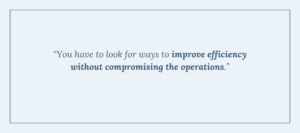
Effective Energy Management for Civic and Justice Facilities
Ted Perry, Senior Vice President with CGL’s facility maintenance division, is an expert on the topic of energy management plans and implementing strategies for initiatives to reduce energy consumption and promote sustainability. In today’s post, he shares his process for developing an effective energy management plan, strategies for reducing energy consumption, and insights on how to increase energy efficiency without sacrificing operational performance.
My Journey into Energy Management and Sustainability
Before joining CGL, I managed operations for a large municipality. This experience gave me insight into the internal struggles of balancing constituent needs versus available funding, addressing deferred maintenance issues, and dealing with staffing challenges. Over the past 15 years with CGL, I’ve worked in various sectors, managing facilities, conducting facility condition assessments, and running operations.
I was drawn to energy management and sustainability due to the growing recognition and awareness of the importance of creating cost-effective and environmentally responsible operations. I’ve seen firsthand how energy inefficiencies and unsustainable practices significantly impacted budgets and environmental footprints. This realization fueled my passion for making a positive impact through energy management.
Developing an Effective Energy Management Plan – Approach and Process

When developing an energy management plan, I start by viewing facilities as opportunities for improvement. My focus is on enhancing operations, improving asset efficiency, and reducing operational costs. Here are the key components of a successful energy management plan:
- Energy Audit: Conduct an assessment to understand energy use patterns and identify inefficiencies.
- Data Gathering: Collect utility bills and operational data to set clear, achievable energy reduction goals aligned with the organization’s mission.
- Stakeholder Engagement: Ensure organizational support through stakeholder involvement.
- Action Plan: Identify and prioritize opportunities for energy savings, such as:
- Upgrading equipment
- Improving insulation
- Incorporating renewable energy sources
- Implementation: Develop budgets, timelines, and resources for executing the action plan.
- Monitoring and Evaluation: Continuously track performance using metering devices and software, comparing results against baseline data.
- Continuous Improvement: Regularly review and adjust strategies to reinforce the importance of energy management efforts.
Effective Strategies for Reducing Energy Consumption

Modernizing older facilities, particularly in the judicial and correctional sectors, is crucial for reducing energy consumption. Effective strategies I’ve implemented include:
- Lighting Upgrades: Transitioning to LED lighting
- Water Conservation: Implementing metering devices and automated valves
- Equipment Replacement: Upgrading to energy-efficient alternatives
If you take large state correctional facilities – those that are over 1,000 beds – most were built between 1980 and 2000, making them 20-40+ years old. Many of these facilities have never had energy management measures introduced. Often, these facilities are some of the state’s biggest assets, while also being the largest employers. When you consider that these facilities operate 24/7, it’s easy to see why these institutions are some of the largest consumers of energy. So, it’s quite impactful when you implement things like newer lighting, such as LEDs; introduce water conservation measures, like metering devices and automated valves that adjust on demand; and then replace some equipment with newer alternatives that are much more energy efficient. These types of changes make a significant impact on energy consumption and cost savings.
Balancing Energy Efficiency with Operational Performance

Certainly, you have to look for ways to improve efficiency without compromising the operations. When it comes down to it, balancing energy efficiency with optimal operational performance involves:
- Alignment: Ensuring energy management plans align with operational requirements.
- Staff Training: Educating staff on energy-saving practices and equipment performance.
- Automated Controls: Utilizing building automation systems for real-time monitoring and control of energy use.
- Water Conservation: Implementing lockout devices to manage water usage effectively.
In many ways, improvements in energy efficiency actually benefit operational performance. It really starts with alignment. You need to align your energy management plans with your operational requirements. As things evolve, there’s staff training that’s involved in energy saving practices and equipment performance. Using technology like automated controls that tie into your building automation systems is one way. Water conservation from lockout devices on your plumbing that reduce water consumption is another way that you can balance that performance.
Case Study: Clayton County Justice Center
One of my most notable projects was the Clayton County Justice Center, a 726,500-square-foot facility comprising a detention center, sheriff’s office, and courthouse. We conducted an energy audit and identified several conservation measures:
- Retrofitting lighting
- Installing automated valves
- Implementing water conservation measures
- Replacing a 16-million BTU boiler with five 3-million BTU boilers
The most significant impact came from the boiler replacement project. The old boilers operated by either being 100% on at full capacity – or they were off. What that meant for the facility is they were heating all the water in the summertime, even though its primary use was for resident showers. They didn’t need it to heat the building like they did in the winter.
When we implemented the individual boilers that worked as a team cascading up and down based off demand, it had a significant impact. This type of installation permitted better maintenance practices as it allowed the team to take one boiler offline and work on it while the others ramped up to meet the demand at the time. By doing that, it resulted in thousands of dollars in fuel cost savings and water reduction savings. The return on investment for the boiler replacement was projected to be between seven to ten years but was achieved in just over three and a half years.
Key Takeaways – Advice for Developing Your Own Energy Management Plans

For those looking to develop effective energy management plans, my advice is:
- Seek Expert Guidance: Partner with experienced professionals or companies.
- Set Clear Goals: Establish obtainable goals that bring significant value and return on investment.
- Leverage Resources: Utilize organizations like Energy Star, USGBC, ASHRAE, IFMA, BOMA, and the Department of Energy for guidelines, certifications, and best practices.
You have to set clear, obtainable goals for your facility. Focus on what would bring you the biggest value for the money you spend, or what would bring you the biggest return on your investment.
If you’re not experienced and you don’t really know where to start, there’s a lot of organizations out there to start educating yourself. My advice would be to get someone who’s been through it – whether that’s a company or an individual that can help guide you. Use their insight and guidance to help walk you through the process, check their track record for success and do your homework.





